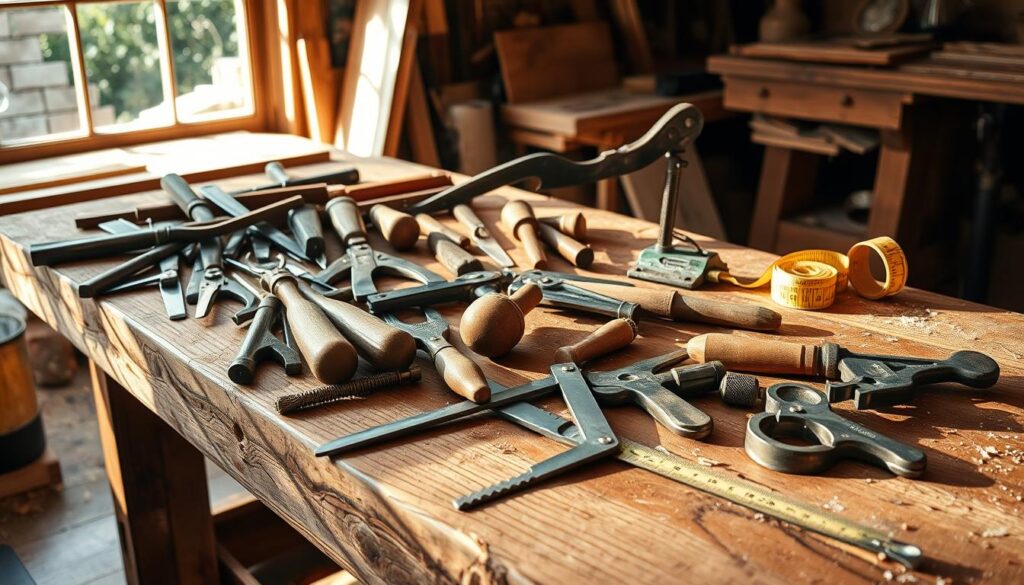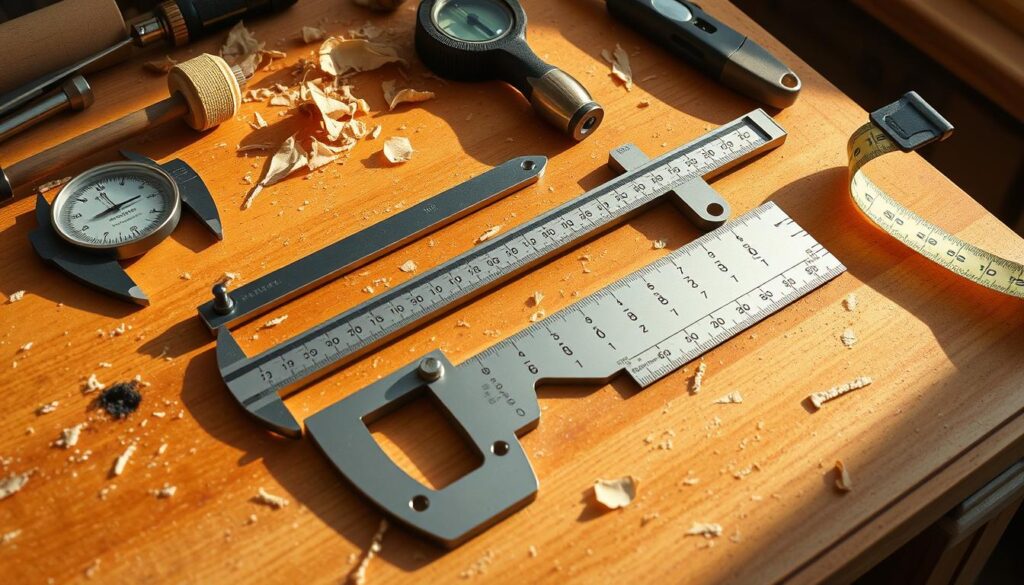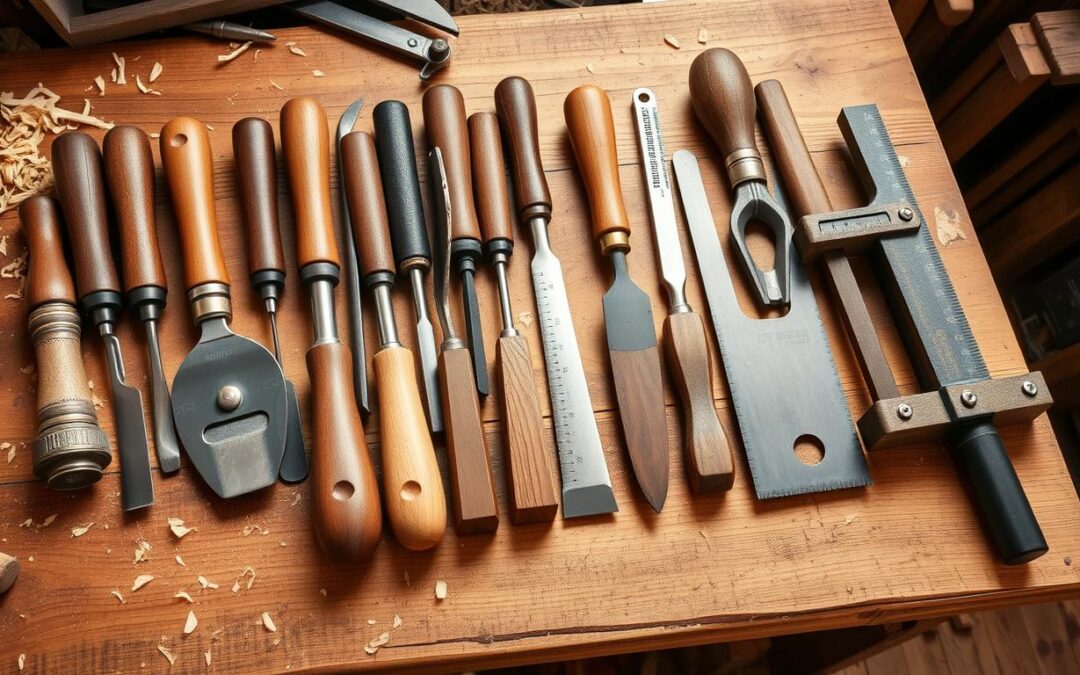Your toolkit is an extension of your skill and passion. It holds essential woodworking hand tools that can turn raw lumber into art. For those who love the craft, hand tools for woodworking are more than tools; they’re essential partners.
These tools offer precision and a connection to wood that power tools can’t match. Using hand tools woodworking lets you connect with your work deeply. This connection enhances your appreciation for the material and the process.
Whether you’re experienced or new, knowing the key woodworking tools hand tools can take your craft to new levels. It brings mastery and satisfaction.
Let’s look at the essential tools every craftsman should have. We’ll see how these tools work with power tools for a balanced woodworking approach. It’s not just about having the right tools. It’s about understanding their value, mastering their use, and passing on quality craftsmanship.
Key Takeaways
- Identify the must-have essential woodworking hand tools for any woodworker’s toolkit.
- Learn why hand tools for woodworking are preferred for precision and connecting with your craft.
- Discover how a solid foundation in hand tools woodworking complements power tools.
- Understand the significance of each tool in perfecting the art of woodworking.
- Embrace the heritage and precision that woodworking tools hand tools bring to your projects.
Understanding Woodworking Hand Tools
Woodworking is both an art and a science. It needs precision, skill, and the right tools. This section explores the world of essential woodworking tools. It also looks at moving from electric tools to the finesse of hand tools.
By learning about different hand tools, you can improve your work. You’ll enjoy a more hands-on approach to woodworking.
An Overview of Hand Tool Woodworking
Hand tools are key for any wood crafter. They offer a level of detail and personal touch that machines can’t match. Whether it’s carving a trim or shaping a tabletop, hand tools provide control and precision.
The Importance of Selecting Quality Hand Tools
Choosing high-quality hand tools is crucial. They last longer, give better results, and are safer. When building your tool collection, focus on durable and ergonomic tools. This ensures each tool adds value to your workshop.
Transitioning from Power Tools to Hand Tools
Switching to hand tools can be rewarding. It lets you work more quietly and with better control. It also reduces dust and noise, making your workspace more enjoyable.
Using both electric and hand tools is best. For those used to electric tools, start with basic hand tools. Gradually expand your skills.
| Tool Type | Benefits | Use Cases |
|---|---|---|
| Chisels | Precision in joinery | Creating joints, carving details |
| Hand Saws | Control over cutting | Making precise cuts for fitting |
| Planes | Smooth finishes | Smoothing wood surfaces, shaping edges |
As you get to know each tool, you’ll see how right tools improve your work. Start adding more hand tools to your collection. Enjoy the tactile joy of woodworking.
Basic Woodworking Tools: The Foundation of Your Toolkit
Every woodworker starts with a solid foundation of essential tools. Whether you’re experienced or new, knowing the key tools is crucial. It helps you create with precision and skill.
Wooden mallets and screwdrivers are at the heart of a carpenter’s toolkit. These tools are used for many tasks, from simple projects to complex furniture. Choosing quality tools is important for durability and effectiveness.
| Tool Type | Description | Use Case |
|---|---|---|
| Claw Hammer | Essential for driving nails and prying apart wood. | Framework, assembling pieces |
| Utility Knife | Sharp blade for detailed cutting and trimming tasks. | Shaping, detailing wood items |
| Chisels | Used to chip, carve and refine wood. | Decorative woodwork, joint work |
| Hand Saw | Cutting tool for dimensional lumber into manageable pieces. | Cutting boards, shaping parts |
| Screwdrivers | For fastening tasks involving screws. | Assembly and repairs |
Adding tools like hammers, screws, levels, and angle finders to your collection is beneficial. It prepares you for detailed projects. Investing in these basic tools can improve your craftsmanship.

As you get better, think about adding specialized tools. Experts often suggest planes, dovetail saws, and wood routers. But, remember, mastering simple tools is key to skilled woodworking.
Measuring and Marking Tools for Precision Work
Woodworking needs precision to make perfect pieces. Using the right tools ensures every cut is just right. Measuring tapes, rulers, marking gauges, and squares are key. Let’s see how they help achieve precision and why they’re essential.
Essential Measuring Tapes and Rulers
There are many measuring tapes and rulers out there. Choosing the right one is crucial for your work. They help you measure accurately, whether for big panels or small details. Accurate tools are vital for keeping your work precise.
Marking Gauges and Their Uses
Marking gauges help you mark lines for cutting or joining. They’re great for setting joints or aligning hinges. Their ability to make precise marks makes them a must-have for fine woodworking.
Using Squares for Accurate Angles
Squares are important for both looks and structure in your projects. They check corners, align parts, and draw straight lines. There are different types of squares for various needs.
Knowing how to use these tools can make your woodworking better. Here’s a quick look at some common tools for measuring and marking:
| Tool Type | Usage | Features |
|---|---|---|
| Measuring Tape | General measurement | Flexible, retractable, varies in length |
| Ruler | Detailed and small measurements | Usually metal or wood, up to 1 meter |
| Marking Gauge | Marking wood for cuts | Adjustable, uses pins or knives |
| Square (Try) | Checking and marking right angles | Rigid, right-angled, various sizes |

Adding these tools to your collection will make your woodworking better. They improve your work’s quality and accuracy. They’re a must for any woodworking lover.
Chisels and Gouges: Crafting Detail in Wood
In the world of hand tool woodworking, chisels and gouges are key. They help with basic cuts and add fine details. Knowing about these tools can make your projects better.
Different Types of Chisels and Their Purposes
Chisels are used to shape wood by removing shavings. They are crucial for precise work. There are many types, each for different tasks:
- Bevel Edge Chisels: Great for tight spaces and precise cuts.
- Mortise Chisels: Thicker, for cutting mortises.
- Pairing Chisels: Long and thin, for shaving off thin wood layers.
Choosing the right chisel is important. It depends on the task at hand, from detailed work to removing wood.
Sharpening and Maintaining Your Chisels
Keeping chisels sharp is key for good performance. A sharp chisel is safer and cuts cleaner. For maintenance, follow these steps:
- Regularly hone with a quality sharpening stone.
- Store tools in a dry place to avoid rust.
- Use wooden mallets, not metal hammers, to prevent chipping.
Gouges: Shaping Curves and Contours
Gouges are curved chisels used for rounded surfaces. They’re great for:
- Sculpture and artistic details.
- Creating grooves and hollows in spoons and bowls.
- Decorative woodwork in architecture.
| Tool Type | Application | Material |
|---|---|---|
| Bevel Edge Chisel | Precision joinery | High carbon steel |
| Mortise Chisel | Heavy-duty mortising | High carbon steel |
| Pairing Chisel | Shaving thin wood layers | High carbon steel |
| Standard Gouge | Carving rounded contours | Alloy steel |
Learning to use these tools well improves your woodworking. It makes your projects better, both functional and decorative.
Saws: Making the Cut
When it comes to essential tools in your woodworking shop, saws for woodworking are at the top. Knowing the different types of saws and their uses can improve your cutting skills. This leads to making precise cuts and beautiful projects.
Each saw has its own purpose, from making curves to straight cuts. To pick the right saw for your project, consider this breakdown:
- Hand Saws: Great for cutting across and along the wood grain. Its versatility makes it a must have woodworking tools.
- Back Saws: Have a stiffened rib for precise cuts in joinery.
- Coping Saws: Perfect for detailed cutting, allowing tight curves and complex shapes.
Choosing the right saw is key for both beginners and experienced woodworkers. Cutting tools for woodworking, including saws, make work easier and improve accuracy. Whether making simple furniture or detailed carvings, the right saw matters a lot.
While the saw type is important, blade quality and technique also matter. Good quality saws and proper sawing techniques are essential. Let these cutting tools for woodworking help you achieve precision and ease in your woodworking.
The Plane Truth: Woodworking Hand Tools for Shaping
If you love hand tool woodworking, you know planes are key for a perfect finish. These tools help smooth out wood, revealing its natural beauty. They prepare it for more detailed work. Each plane, like block, bench, and specialty planes, has its own role in your toolkit.
Bench planes are great for big surfaces. They help flatten and smooth out large areas. Whether you’re working on a big piece of furniture or making small adjustments, these planes are crucial. They show off your skill as you make surfaces perfectly flat for joinery or finishing.
For those who love precision, specialty planes like rabbet and shoulder planes are a must. They help create exact joints and reach tight spots. Block planes, being small, are perfect for shaping ends or quick touch-ups. Mastering these planes shows your deep commitment to hand tool woodworking.
FAQ
What are the essential woodworking hand tools every craftsman should have?
Every craftsman needs a hammer, screwdrivers, and chisels. They also need saws, measuring tools, and a square. A marking gauge, planes, and gouges are also key. These tools help with precision and basic construction.
Why is it important to select quality hand tools for woodworking?
Quality hand tools last longer and work better. They are more durable and efficient. This means better results and less need to replace them often.
How can a woodworker transition from using power tools to hand tools?
Start by using hand tools for tasks that need precision. Gradually use them more as you get better. This way, you learn how to use them effectively.
What are some basic woodworking tools necessary for beginners to start their toolkit?
Beginners should get a hammer, screwdrivers, and chisels. A hand saw, measuring tools, and a square are also essential. These tools help you start with basic woodworking projects.
How do marking gauges and squares contribute to precision in woodworking?
Marking gauges help make straight lines. Squares check angles and ensure cuts are right. This is key for accurate woodworking.
What are the different types of chisels and their purposes?
There are many chisels for different tasks. Bench chisels are versatile. Mortise chisels cut mortises, and paring chisels shape joints. Dovetail chisels are for dovetail joints.
What are the key aspects of maintaining your chisels?
Keep chisels sharp by honing and sharpening them. Store them right to avoid damage. Clean them to prevent rust. Use them correctly to avoid wear.
Why are saws considered essential woodworking hand tools?
Saws are key for cutting wood accurately. They’re used for straight and curved cuts. Different saws are needed for different tasks.
What are the different types of woodworking planes and their uses?
Woodworking planes include block planes for trimming and bench planes for smoothing. Jack planes level rough lumber. Specialty planes are for shaping moldings. Each plane has a specific use.

